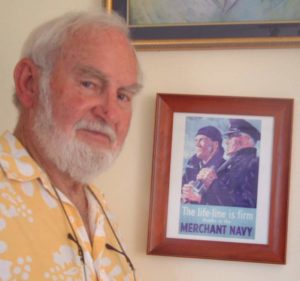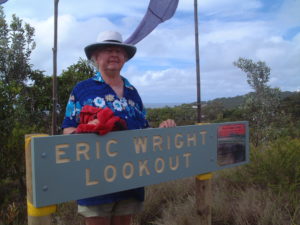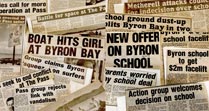 Ron Ware, a real man of the sea
Ron Ware, a real man of the sea
RON Ware was truly a man of the sea.
The life of the master mariner reads like a Hollywood adventure movie script, the difference being all his adventures were real.
Ron – or Captain Ware – began his long association with the ocean rowing in surf life saving boats while at school in Newcastle.
As a teenager, the urge to go to sea was overwhelming and at the age of 14, he raised his age and joined the British Merchant Navy during the Second World War.
By the time he was 18 he had experienced the horror several times of having his ship blown out of the water by enemy bombs and torpedoes, and obviously surviving the experiences.
One of those experiences included surviving 10 days on a raft off South Africa.
His other wartime experiences included service in the Australian merchant marine, flying with the RAF and RAAF in Catalinas searching for U-boats off South Africa, flying in a RAAF Beaufort as a waist gunner on two operational strikes against Japanese positions, and a day with Australian infantry in the mountains behind Wewak in Papua-New Guinea.
He later went on to hold commands in the merchant navy and in the Royal Australian Navy and among a host of achievements, he completed an American masters degree in marine science.
His marine research included investigations into hundreds of shark attacks around the world, including an attack on a high school student in 1989 at Evans Head.
He concluded after that attack that there was sufficient evidence to suggest that a pod of dolphins had come to the aid of the student during the attack.
As the great-great-great-great-grandson of Captain William Bligh, a central figure in the Bounty mutiny, Ron was always going to have a major connection with the sea.
In 1983, in a longboat he had specially built in New Zealand, and with a crew of eight, he covered the same 6400km longboat journey of Bligh and his men from the island of Tofua to Timor.
He described the 42-day journey as an “epic in its own right”, with the wind and seas at times more violent than those encountered by Captain Bligh.
At the time, he said the open boat voyage was the “climax of 30 years at sea”.
“It increased my estimation of Bligh as a navigator and seaman,” he said. “Bligh was a seaman’s seaman, more so than Cook.”
Six years later in 1989, Ron played a central part in the bicentenary re-enactment of the mutiny in the South Pacific, commanding a modern-day replica of the original Bounty.
Ironically, his second-in-command was the Royal Australian Navy’s Lt-Cmdr Gerry Christian, a great-great-great-great-grandson of Fletcher Christian, who led the mutiny and whose company, he said, he “enjoyed”.
Ron, who moved to the Byron Shire with his wife Joanna and family in 1988, first to Coorabell and then later to Suffolk Park, was proud of his status as a surfing elder.
He began surfing in 1945 and won a national senior title at Bells Beach aged 45. There is a photo of him in the Surfing Hall of Fame at Torquay riding a 20ft Bells Beach wave.
He was still riding his longboard, mostly at Wategos, into his 80s. Despite not being able to paddle out in latter years, he walked a number of laps of the beach at Wategos just about every morning.
Ron was a leading member of PASS – Preservation and Safe Surfing – formed to lobby for surfers’ rights at The Pass during the 80s and 90s.
In 2005, he spoke out forcefully against a Cape Byron Trust decision to charge locals to park at The Pass and Cosy Corner, describing it as a “gross injustice”.
A proud RSL member who was always at the front of the Byron Bay Anzac Day parade, Ron was selected by the Australian Government to represent merchant seaman at the opening of a memorial in London in 2003 honouring Australian servicemen and women.
Ron Ware was an extraordinary man who led an extraordinary life.
At the time of his death aged 86 in 2011, Ron was survived by his wife Joanna, nine children, eight grandchildren and 16 great-grandchildren.
His funeral was held at St Finbarr’s Catholic Church.
Eric Wright – Mr Byron Bay
THE Byron Bay that Eric Wright left behind when he died aged 86 in 2004 was a lot different to the one he knew as a boy growing up in the town.
But for all its dramatic changes over the years which saw Byron Bay move from a small country town to an international tourist destination, Eric never lost his passion and love for the town, or its history. 
If anyone could have comfortably worn the mantle, ‘Mr Byron Bay’, it was him.
Visiting his long-time home in Cooper Street, as I did many times, was a bit like stepping back in Byron Bay time.
He had a vast collection of Byron Bay memorabilia and thousands of historical photographs of Byron Bay people and places and photographs he had taken himself.
Eric’s knowledge of events in the Bay through the years and its people was vast.
And he was always more than willing to share that knowledge with anyone who cared to ask.
For several years, he wrote a Byron Bay history column for the Byron News which became a valuable record for anyone interested in the town’s past. He also provided valuable assistance to Maurice Ryan for his book Time and Tide, A History of Byron Bay, published in 1984.
Born in Kyogle on August 6, 1918, Eric, with his father and mother, Reg and Maud, moved to Coopers Shoot in 1920 and then to a five acre block at ByronBay.
He started at Byron Bay Public School in 1925 and later went to Mullumbimby District Rural School, leaving school just after turning 14 and starting work at Norco butter factory, now the site of the Byron Bay Services Club.
Eric clocked up 50 years at Norco, the only employee to do so, retiring on Christmas Eve 1982.
During the second world war, he joined the RAAF and served in Darwin, New Guinea, the Philippines and the China coast, returning to Australia in 1946.
He married his wife Nella in 1948 and they moved into the house in Cooper Street across the paddock from his parents house. Cancer claimed Nella in 1984.
Before the war Eric had joined the Byron Bay Surf Club and was made a life member in 1983. He also played hockey for the Byron Bay B Grade side from 1947 to 1952.
His other interests included growing orchids and lapidary, the many rock samples in his house evidence of this.
A staunch member of the RSL, Eric also was a foundation director of the Byron Bay Services Club, foundation president of the Byron Bay Historical Society and a long-time member of the Masonic group, Lodge Cavanbah.
Up until a couple of years before his death, Eric was a familiar site around town and he could still be seen regularly walking along Bangalow Road into town.
Battling illness, he moved into the Ballina Ex-Servicemen’s Home.
Eric’s contribution to Byron Bay was marked when a lookout at Paterson Hill in Paterson Street overlooking the Bay and land saved from development, was named after him.
It was a proud day for Eric and an honour well deserved.
Eric’s funeral was held at the Byron Bay Uniting Church and he was buried at Byron Bay Cemetery.
